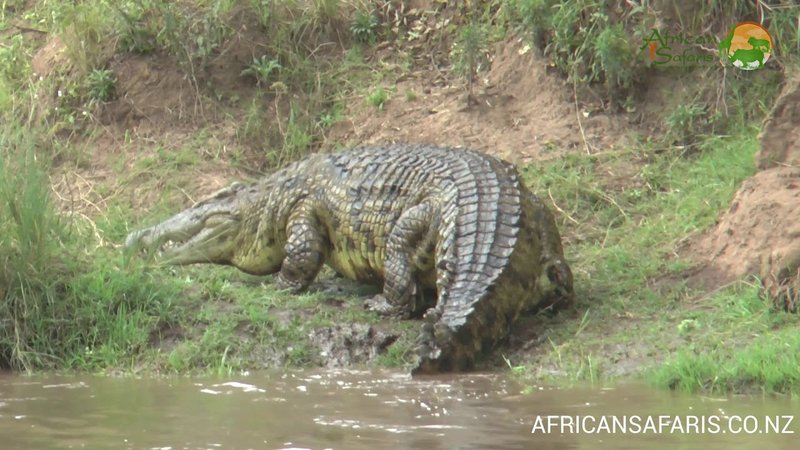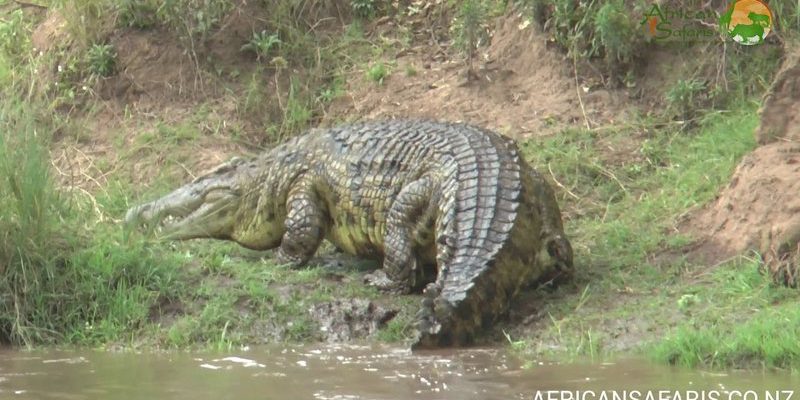
The Nile crocodile, a majestic reptile of Africa, is often looked upon with a mixture of awe and fear. Imagine a creature that has been around since the time of the dinosaurs, gliding through the water with the grace of a dancer yet equipped with the powerful jaws of a predator. This crocodile is not merely a relic of the past; it plays a crucial role in the ecosystem of the rivers and lakes it inhabits.
Nile crocodiles are fascinating not just for their size, which can reach up to 20 feet, but for their behaviors and habitats. They are primarily found in rivers, lakes, and marshlands throughout sub-Saharan Africa. You might picture them sunbathing on riverbanks or lurking just beneath the surface, waiting for unsuspecting prey. As we explore the life of the Nile crocodile, you’ll gain insights into its diet, behavior, habitat, and the vital role it plays in its ecosystem.
Physical Characteristics
The Nile crocodile is a large reptile, and its physical characteristics are nothing short of impressive. With a long, muscular body and a powerful tail, it can move quickly both in water and on land. Their skin is covered in tough, scaly armor, which helps protect them from predators and the elements. Most adults range from 10 to 16 feet in length, but some can grow even larger, with weights exceeding 1,600 pounds.
One of the most striking features of the Nile crocodile is its jaw. Equipped with over 60 sharp teeth, these jaws can exert a bite force of up to 5,000 pounds per square inch, making them one of the strongest bites in the animal kingdom. This sheer power allows them to crush bones and hold onto large prey. Their eyes, located on the top of their heads, provide excellent vision above water while they remain almost fully submerged, allowing for stealthy hunting.
Color-wise, Nile crocodiles can vary. They usually sport a dark olive or brown coloration, which helps them blend into their surroundings. This camouflage is essential for both hunting and avoiding human detection. Overall, the combination of size, strength, and adaptability makes the Nile crocodile a formidable predator in its environment.
Habitat and Distribution
Nile crocodiles are primarily found in a variety of freshwater habitats across Africa. They thrive in rivers, lakes, and marshes, where they can easily hunt and bask in the sun. The Nile River, after which they are named, is perhaps their most famous habitat, but they also inhabit many other areas, including the Zambezi River and Lake Victoria.
These reptiles prefer warm, shallow waters, where they can lounge on the banks or swim gracefully. They often seek out sun-drenched spots to regulate their body temperature, which is crucial for their cold-blooded physiology. During the rainy season, they may be found in areas that would typically be dry, as rising waters expand their territory and available hunting grounds.
Interestingly, despite their preference for fresh water, Nile crocodiles can tolerate brackish water. This adaptability allows them to survive in various environments, making them one of the most widespread crocodile species in Africa. Their flexibility in habitat choice is a significant factor in their survival and success as a species.
Diet and Hunting Techniques
The Nile crocodile is an opportunistic carnivore, meaning it will eat just about anything it can catch. Its diet predominantly consists of fish, birds, and mammals that venture too close to the water’s edge. They are also known to take down larger prey, such as antelope or even young hippos, demonstrating their power and hunting prowess.
When hunting, Nile crocodiles employ a variety of strategies. They often lie in wait, hiding just beneath the surface of the water with only their eyes and nostrils exposed. This allows them to stalk prey stealthily. Once they detect a target, they can launch themselves out of the water with incredible speed and power to catch their meal, using a swift snap of their jaws.
Another fascinating aspect of their hunting technique is their ability to perform a “death roll.” Once they capture their prey, they twist their bodies rapidly in the water to subdue and dismember it, making it easier to swallow. This method is not only efficient but also demonstrates the crocodile’s physical strength and agility. It’s a brutal display of nature’s raw power, reminding us of the circle of life in the animal kingdom.
Reproduction and Lifespan
Nile crocodiles reach sexual maturity between 10 to 15 years, depending on environmental conditions like food availability and habitat stability. Mating typically occurs during the warmer months, and like many reptiles, Nile crocodiles are oviparous, meaning they lay eggs. Females can lay between 25 to 80 eggs in a single clutch, burying them in the sand or vegetation near the water’s edge to incubate.
During the 70 to 90 days of incubation, the mother will guard her nest fiercely against potential threats, including other predators. After hatching, the young crocodiles are about 12 inches long and are vulnerable to a variety of threats, including birds of prey and larger fish. Interestingly, the sex of the hatchlings can be influenced by the temperature of the nest; warmer temperatures tend to produce males, while cooler temperatures yield females.
Conservation Status
The conservation status of Nile crocodiles is somewhat mixed. While they are currently classified as “Least Concern” by the IUCN, local populations can be threatened by habitat loss, hunting, and human-wildlife conflict. As human populations expand and encroach on their natural habitats, Nile crocodiles face challenges, including loss of nesting grounds and increased risk of poaching.
In some regions, efforts are underway to manage and protect these reptiles, including habitat restoration and awareness campaigns to educate local communities about their ecological importance. For instance, in certain wildlife reserves, Nile crocodiles are protected by law, and programs are implemented to monitor their populations. This helps ensure that they continue to thrive in their natural habitats.
Interesting Facts About Nile Crocodiles
| Average Size: | 10-16 feet long |
| Weight: | Up to 1,600 pounds |
| Average Lifespan: | 70-100 years |
| Diet: | Fish, birds, mammals |
| Top Speed: | Up to 15 mph in water |
| Threats: | Habitat loss, poaching |
FAQ
What do Nile crocodiles eat?
Nile crocodiles are opportunistic feeders, meaning they will consume a wide variety of prey. Their diet primarily includes fish, birds, and mammals that venture too close to the water’s edge. They can even take down larger animals like antelope if the opportunity arises. This predator is known for its ability to adapt its hunting techniques based on the available food sources.
How fast can Nile crocodiles move?
In water, Nile crocodiles can swim at speeds of up to 15 miles per hour. On land, they are not as fast, but they can still cover short distances quickly when needed. Generally, they prefer to conserve their energy and do most of their movement in water, where they are most agile.
How long do Nile crocodiles live?
On average, Nile crocodiles can live between 70 to 100 years in the wild, depending on environmental conditions and threats. In captivity, some individuals have been known to live over a century! Their long lifespan allows them to play a significant role in their ecosystems for many decades.
Are Nile crocodiles dangerous to humans?
Yes, Nile crocodiles can be dangerous to humans, especially if provoked or during the nesting season. They are responsible for a number of attacks each year, primarily when people venture too close to their territory. It’s essential to maintain a safe distance and respect their natural habitats.
How do Nile crocodiles reproduce?
Nile crocodiles are oviparous, meaning they lay eggs. A female will typically lay between 25 to 80 eggs, burying them in the sand or vegetation near water. The eggs incubate for about 70 to 90 days, during which the female guards the nest fiercely. Hatching occurs primarily in warmer months, ensuring the best chances for survival.
Where can I find Nile crocodiles?
Nile crocodiles are distributed across sub-Saharan Africa. They inhabit various freshwater ecosystems, including rivers, lakes, and marshlands. Famous locations like the Nile River, Zambezi River, and Lake Victoria are well-known habitats for these reptiles, although they can be found in many other regions as well.
What role do Nile crocodiles play in their ecosystem?
Nile crocodiles play a crucial role as apex predators in their habitats. By controlling the population of various species, they help maintain a balanced ecosystem. Their hunting activities can prevent overpopulation of certain fish and mammal species, which in turn helps sustain the overall health of their environment.
Can Nile crocodiles tolerate saltwater?
While Nile crocodiles primarily inhabit freshwater environments, they can tolerate brackish water, making them adaptable to different habitats. This ability to survive in varied water conditions gives them a wider distribution and allows them to thrive in areas where other crocodilian species might struggle.
What are the main threats to Nile crocodiles?
Main threats to Nile crocodiles include habitat loss due to human expansion and agricultural development, as well as poaching for their meat and skin. Conservation efforts are essential to protect these reptiles and their natural habitats, as they play an important role in maintaining the health of ecosystems across Africa.
How do Nile crocodiles communicate?
Nile crocodiles communicate using a variety of vocalizations, especially during mating season. They can hiss, grunt, or make a low growl to signal their presence or establish territory. Young crocodiles are known to emit distress calls to attract their mother’s attention when in danger. This vocal communication is vital for their social interactions.

